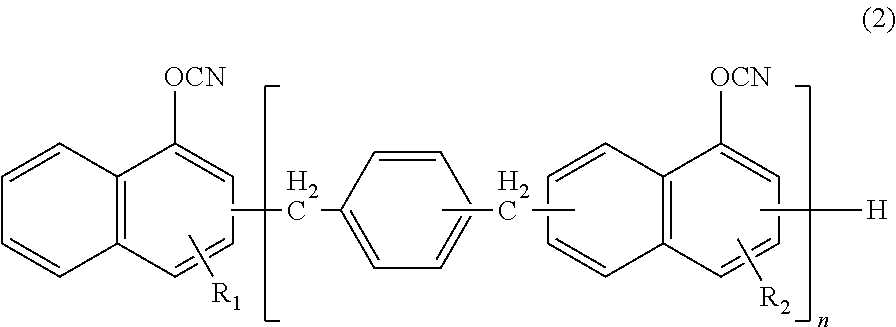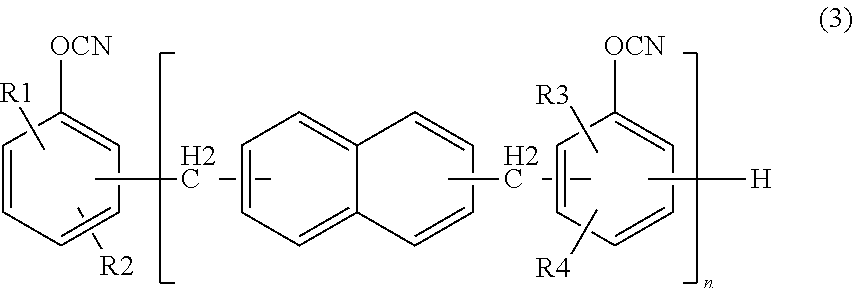Composition for forming underlayer film for lithography, underlayer film for lithography and pattern forming method
a technology of lithography and film thickness, applied in the direction of photomechanical equipment, photosensitive material processing, instruments, etc., can solve the problems of difficult to achieve resist pattern having a film thickness sufficient for processing a substrate, and the intrinsic limitation of light source wavelength, so as to achieve excellent heat resistance and etching resistance
- Summary
- Abstract
- Description
- Claims
- Application Information
AI Technical Summary
Benefits of technology
Problems solved by technology
Method used
Image
Examples
production example 1
[0178]A four-neck flask having a bottom outlet and an inner volume of 10 L, equipped with a Dimroth condenser, a thermometer and a stirring blade was prepared. To this four-neck flask were charged 1.09 kg (7 mol, produced by Mitsubishi Gas Chemical Company, Inc.) of 1,5-dimethylnaphthalene, 2.1 kg (28 mol as formaldehyde, produced by Mitsubishi Gas Chemical Company, Inc.) of a 40% by mass aqueous formalin solution and 0.97 mL of 98% by mass sulfuric acid (produced by Kanto Chemical Co., Inc.) under a nitrogen stream, and allowed the reaction to run under normal pressure for 7 hours with refluxing at 100° C. Thereafter, ethylbenzene (special grade chemical, produced by Wako Pure Chemical Industries, Ltd.) (1.8 kg) as a dilution solvent was added to the reaction solution and left to stand, and then an aqueous phase being a bottom phase was removed. Furthermore, the resultant was neutralized and washed with water, and ethylbenzene and the unreacted 1,5-dimethylnaphthalene were distille...
example 6
[0204]Then, the composition for forming an underlayer film for lithography in Example 1 was coated on a SiO2 substrate having a film thickness of 300 nm, and baked at 240° C. for 60 seconds and further at 400° C. for 120 seconds to thereby form an underlayer film having a film thickness of 70 nm. A resist solution for ArF was coated on the underlayer film, and baked at 130° C. for 60 seconds to thereby form a photoresist layer having a film thickness of 140 nm. As the resist solution for ArF, one prepared by blending 5 parts by mass of the compound of the following formula (10), 1 part by mass of triphenylsulfonium nonafluoromethanesulfonate, 2 parts by mass of tributylamine, and 92 parts by mass of PGMEA was used.
[0205]A compound of following formula (10) was prepared as follows. That is, 4.15 g of 2-methyl-2-methacryloyloxyadamantane, 3.00 g of methacryloyloxy-γ-butyrolactone, 2.08 g of 3-hydroxy-1-adamantyl methacrylate and 0.38 g of azobisisobutyronitrile were dissolved in 80 mL...
example 7
[0208]Except that the composition for forming an underlayer film for lithography in Example 2 was used instead of the composition for forming an underlayer film for lithography in Example 1, the same manner as in Example 6 was performed to provide a positive-type resist pattern.
PUM
| Property | Measurement | Unit |
|---|---|---|
| temperature | aaaaa | aaaaa |
| temperature | aaaaa | aaaaa |
| temperature | aaaaa | aaaaa |
Abstract
Description
Claims
Application Information
 Login to View More
Login to View More - R&D
- Intellectual Property
- Life Sciences
- Materials
- Tech Scout
- Unparalleled Data Quality
- Higher Quality Content
- 60% Fewer Hallucinations
Browse by: Latest US Patents, China's latest patents, Technical Efficacy Thesaurus, Application Domain, Technology Topic, Popular Technical Reports.
© 2025 PatSnap. All rights reserved.Legal|Privacy policy|Modern Slavery Act Transparency Statement|Sitemap|About US| Contact US: help@patsnap.com



